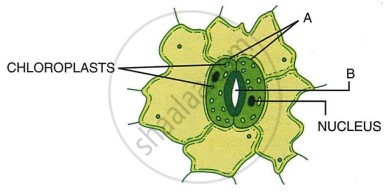Advertisements
Advertisements
Question
Solution
APPEARS IN
RELATED QUESTIONS
Give Reasons for the following:
Guard cells are small in size and are kidney-shaped in outline.
Differentiate Between Cobalt chloride paper and Goat’s bladder.
Given below are the diagrams of a certain structure in plants in two conditions.

(i) Name the structure shown.
(ii) Name the parts numbered 1-5.
(iii) What is the most apparent difference between A and B in the structure shown?
(iv) Describe the mechanism which brings about the change in the structure depicted in A and B.
Given below is the diagram of an experimental set up to study the process of transpiration in plants. Study the same and then answer the questions that follow:

(i) What is the colour of dry cobalt chloride paper?
(ii) Is the experimental leaf a monocot or a dicot? Give a reason to support your answer.
(iii) Why axe glass slides placed over the dry cobalt chloride papers?
(iv) After about half an hour what change, if any, would you expect to find in the cobalt chloride paper placed on the dorsal and ventral sides of the leaf? Give a reason to support your answer.
(v) Define the term ‘transpiration’.
Given below is an apparatus used to study a particular process in plants. Study the same and answer the questions that follow :

(i) Name the apparatus.
(ii) Mention one limitation of this apparatus.
(iii) Which phenomenon is studied with the help of this apparatus?
(iv) What is the function of the part marked ‘reservoir’?
(v) What is the role of the air bubble in the experiment?
Draw a neat diagram of the stomatal apparatus found in the epidermis of leaves and label the Stoma, Guard cells, Chloroplast, Epidermal Cells, cell wall and Nucleus.
Assertion (A): The loss of excess water from the aerial parts of the plant in the form of water vapor is known as transpiration.
Reason (R): Stomata of the leaf perform transpiration.
The upper layer of mesophyll in a leaf consists of elongated ground tissue called ______.
Given below is the figure of a stoma. Study the same and answer the following questions:

- Label the guidelines A and B.
- Write the exact location of the above-mentioned structures.
- Mention one important role of structure A.
- Write three important roles for structure B.
- Redraw the same figure when structures A are in flaccid condition. When does the flaccid condition occur?
